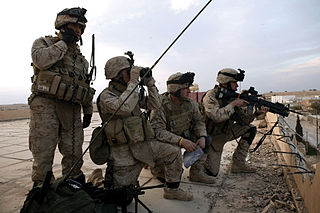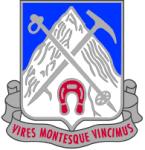
ISTAR stands for intelligence, surveillance, target acquisition, and reconnaissance. In its macroscopic sense, ISTAR is a practice that links several battlefield functions together to assist a combat force in employing its sensors and managing the information they gather.

In military science, suppressive fire is "fire that degrades the performance of an enemy force below the level needed to fulfill its mission". When used to protect exposed friendly troops advancing on the battlefield, it is commonly called covering fire. Suppression is usually only effective for the duration of the fire. It is one of three types of fire support, which is defined by NATO as "the application of fire, coordinated with the maneuver of forces, to destroy, neutralise or suppress the enemy".

A military artillery observer,spotter or FO is responsible for directing artillery and mortar fire onto a target and may be a Forward Air Controller (FAC) for close air support and spotter for naval gunfire support. Also known as Fire Support Specialist or FiSTer, an artillery observer usually accompanies a tank or infantry maneuver unit. Spotters ensure that indirect fire hits targets which the troops at the fire support base cannot see.
In weaponry, a Kill Box is a three-dimensional target area, defined to facilitate the integration of coordinated joint weapons fire.

The Tactical Air Control Party, commonly abbreviated TACP, is a small team of military personnel who provide coordination between aircraft and ground forces when providing close air support.

Air Naval Gunfire Liaison Company (ANGLICO) is an airborne fire support and liaison unit of the United States Marine Corps. The mission of ANGLICO is "To provide Marine Air-Ground Task Force (MAGTF) Commanders a liaison capability to plan, coordinate, and conduct terminal control of fires in support of joint, allied, and coalition forces." Per this mission statement, ANGLICOs are not designed to support U.S. Marine Corps maneuver elements. Instead, the doctrinal purpose of ANGLICO is to provide fire support and coordination in support of units adjacent to the MAGTF.

The 10th Marine Regiment is an artillery regiment of the United States Marine Corps based at Marine Corps Base Camp Lejeune, North Carolina. They fall under the command of the 2nd Marine Division and the II Marine Expeditionary Force.
Battle-space is a term used to signify a unified military strategy to integrate and combine armed forces for the military theatre of operations, including air, information, land, sea, cyber and space to achieve military goals. It includes the environment, factors, and conditions that must be understood to successfully apply combat power, protect the force, or complete the mission. This includes enemy and friendly armed forces, infrastructure, weather, terrain, and the electromagnetic spectrum within the operational areas and areas of interest.

The Gladiator Tactical Unmanned Ground Vehicle program was developed in order to support the United States Marine Corps conduct of Ship To Object Maneuver (STOM) missions through the use of a medium-sized, robotic system to minimize risks and eliminate threats to Marines during conflict. The Gladiator is able to perform surveillance, reconnaissance, assault and breaching missions within its basic technical configuration.
Sticky foam is a type of less-lethal weapon, consisting of various extremely tacky and/or tenacious materials carried in compressed form with a propellant and used to block, entangle, and impair individuals.

The reorganization plan of the United States Army is a current modernization and reorganization plan of the United States Army that was implemented under the direction of Brigade Modernization Command. This effort formally began in 2006 when General Peter Schoomaker, was given the support to move the Army from its Cold War divisional orientation to a full-spectrum capability with fully manned, equipped and trained brigades; this effort was completed by the end of 2016. It has been the most comprehensive reorganization since World War II and included modular combat brigades, support brigades, and command headquarters, as well as rebalancing the active and reserve components. The plan was first proposed by the Army's 34th Chief of Staff, Eric Shinseki, in 1999, but was bitterly opposed internally by the Army. By 2020, the Army's 40th Chief of Staff was calling for transformational change, rather than incremental change by the Army. In 2021, Gen. McConville, the Army's 40th Chief of Staff, laid out Aimpoint 2035, a direction for the Army to achieve Corps-level Large-scale combat operations (LSCO) by 2035, with Waypoints from 2021 to 2028.

The United States Army Armor School is a training school located at Fort Benning, Georgia. Its primary focus is the training of United States Army soldiers, non-commissioned officers, warrant officers, and commissioned officers in the operation, tactics, and maintenance of armor forces and equipment including the M1 Abrams main battle tank, the Bradley Fighting Vehicle, the Stryker Mobile Gun System, assorted crew-served and personal weapons, and various other equipment including radios. The school is also the site where U.S. Marines are sent for training on the Abrams tank. The Armor School moved to Fort Benning in 2010 as part of the United States' Base Realignment and Closure program.
Area of Responsibility (AOR) is a pre-defined geographic region assigned to Combatant commanders of the Unified Command Plan (UCP), that are used to define an area with specific geographic boundaries where they have the authority to plan and conduct operations; for which a force, or component commander bears a certain responsibility. The term may also be used in other countries worldwide but it originated within the United States Armed Forces. This system is designed to allow a single commander to exercise command and control of all military forces in the AOR, regardless of their branch of service.

The 2nd Battalion, 87th Infantry Regiment is a United States Army infantry battalion. Originally formed during World War II, the battalion took part in the Aleutian and Italian campaigns before being deactivated after the war. Later, however, it was reactivated and in recent times has served in the Sinai Peninsula and in Afghanistan.
The United States Marine Corps is assigned by the National Command Authority to be primarily the Department of Defense's expeditionary force-in-readiness, and the Department of the Navy's contingent landing force—amphibious by nature. Before 2006, the Marine Corps was the only branch of the Armed Forces that did not have any of its special warfare elements participating in the United States Special Operations Command (USSOCOM), due to confining its special operations capabilities only for the purpose to the Fleet Marine Force.
The reconnaissance mission within the United States Marine Corps is divided into two distinct but complementary aspects; Marine Division Recon and Force Reconnaissance.
Train Advise Assist Command – East is a multinational military formation, part of NATO's Resolute Support Mission within Afghanistan. It is the former Regional Command East of the International Security Assistance Force (ISAF). The United States Army provides the force headquarters. The command headquarters is located in Laghman Province.

Project Manager Mission Command is a component of Program Executive Office Command, Control and Communications-Tactical in the United States Army. PM MC develops, deploys and sustains integrated Mission Command software capabilities to the Army and Joint forces. PM MC’s support ensures tactical and other unit types are efficiently fielded, effectively trained and professionally supported. Product lines include the areas of maneuver, fires, sustainment, and infrastructure.
The Marine Air Command and Control System (MACCS) is the aviation command and control agencies of the United States Marine Corps that provide the Aviation Combat Element (ACE) commander with the means to monitor, supervise, and influence aviation operations in support of the Marine Air-Ground Task Force. The command and control agencies of the MACCS are provided by the squadrons and battalions of the Marine Air Control Groups that are present within each Marine Air Wing. The capabilities resident within the MACCS allow the MAGTF commander to safely conduct aviation operations, facilitate timely maneuver and prosecution of fires and ultimately retain full control of their entire area of operations. MACCS agencies are also responsible for coordinating Marine Corps aviation operations with joint, multinational and civil aviation.










